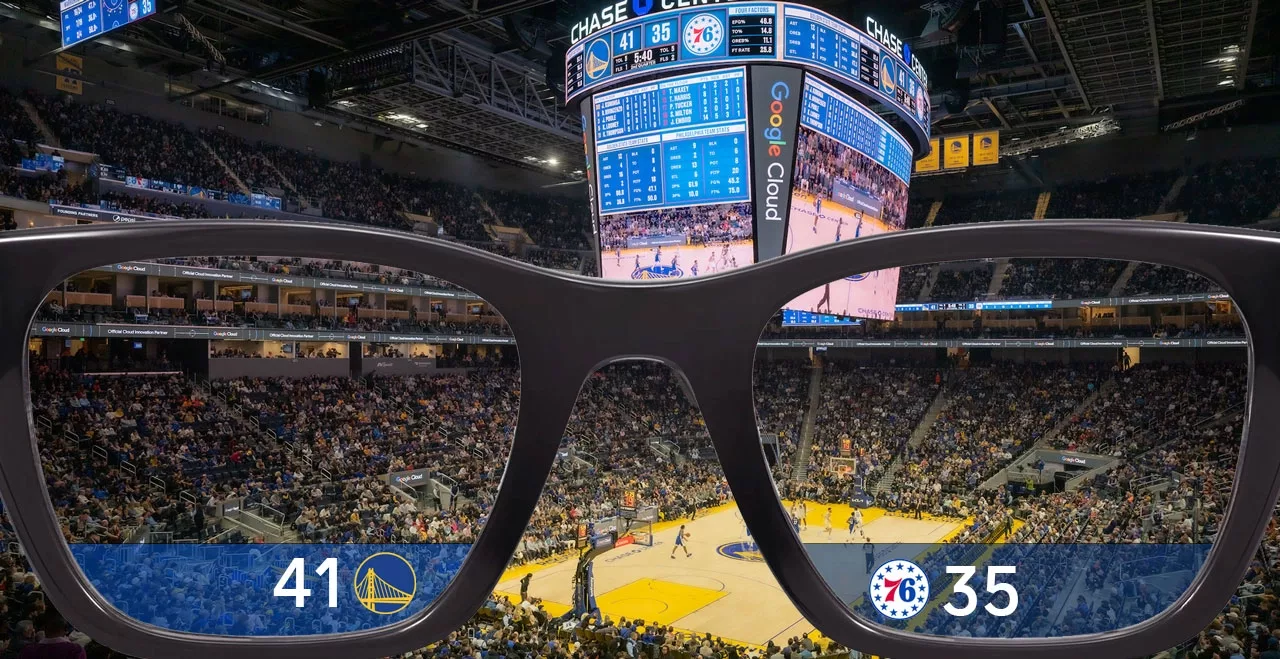The Mixed Reality Future of In-Stadium Sports Experiences
The future of in-stadium experiences involves mixed reality glasses that augment the visualization on the floor or pitch.

The future of in-stadium experiences involves mixed reality glasses that augment the visualization on the floor or pitch.
Subscribe
Google Glass was a failed experiment.
The year is 2024.
Spatial computing and artificial intelligence (AI) have taken the forefront. Visions of a fully automated, potentially robotic (i.e. humanoid) future and a three-dimensional (3D) internet are on the horizon with Meta and Rayban leading the charge in augmented reality "smart" glasses, after the deception that was Google Glass.

Philadelphia 76ers at Golden State Warriors (Chase Center, San Francisco).
Curiously, within stadiums all around the world, fans are still experiencing sports as we have for over 100 years with the only addition being stadium round interactive screens and Jumbotrons that display advertising and relevant information.
Meanwhile, fans at home are getting augmented reality LIVE streams powered by Microsoft or other technology giants that inform them of players names and real-time relevant stats and strategic information.

An example of LaLiga Beyond Stats powered by Microsoft.

Strategic information can be how the defensive lines are drawn.
This raises a question:
Has the at-home experience surpassed the in-stadium experience? And if so, how can we elevate the in-stadium experience to the new era?
As a faithful of sports, I understand the value of being surrounded by others within a stadium.
The energy, the tension, the sound; an ecstasy or devastation shared by 85,000 people without forgetting the key aspect: witnessing history, in-person.
These are elements that a broadcast or immersive experience could never provide as you are physically separated from that energy.
However, when watching sports that I am less passionate about, I begin to notice where things fall short and how the in-stadium could be elevated to bring together the best of both worlds.
ATP BNP Paribas Open used NeRFs to produce "FreeD."
The ideas that come to mind become increasingly more realistic and possible as replays which use NeRF technology begin to be used by the ATP at the BNP Paribas Open.
An innovation that demonstrates that we are not too far from real-time 3D broadcasts powered by 5G which will be offered to the public through broadcasters (who currently own the broadcasting rights) or clubs (i.e. franchises), if A22 get's their way after a landmark ruling by the European Court of Justice.

Smart glasses could reduce the amount of time spent looking away from the game by providing contextual information at a glance.
The first innovations that must be provided to the general public must bring value and be low hanging fruit.
An example of this would be to put the score information out of sight, at the top or bottom of the smart glasses.
This is particularly important in high scoring, dynamic games (i.e. Basketball or Tennis) where so much happens so quickly that it is difficult to keep track of the score - causing fans to have to look at the Jumbotron instead of the game.

The FIFA+ app allowed for LIVE visualizations through a smart phone.
Other innovations which may be useful include player trackers and labels as well as statistics or data visualizations similar to those offered by the FIFA as part of their FIFA+ Stadium Experience during the FIFA World Cup Qatar 2022.
As glasses do not have a traditional touch-based user interface, users would adapt the visualizations shown by the glasses using AI-enabled voice prompts, a future which is increasingly more possible thanks to OpenAI, Google, Anthropic and soon, Apple.

Advertising would initially cover the lead sponsors and would eventually be specific to the individual watcher.
A question that has been raised by many of the individuals whom I have discussed the concept with in-stadium is:
Who is going to be able to pay for it and how is it going to make money?
The truth is that until glasses become a universal platform similar to the iPhone or Android smartphone, it is unlikely that individuals will own such a gadget.
Instead, I believe that these glasses will initially be given to season ticket holders and will eventually come with individual match tickets, with their cost being subsidized by advertising that ties the eye and profile of a consumer to what they see.
Examples include:
- Advertising below the scoreboard.
- The physical interactive screens that currently show advertising will overlay specific advertising relevant to the individual instead everyone seeing the same thing.
- Floating advertising on top of players (i.e. like the Microsoft logo on top of Karim Benzema in the image above).
- Advertising covering the entire volume surrounding the game.
Smart glasses can make entertainment more accessible

Smart glasses could offer real-time commentary, subtitles or translations.
To read our take on how smart glasses break barriers and make theater and cinema more accessible, consult the link below.